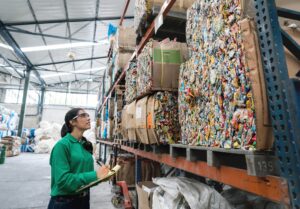Plastic reduction, reuse and recycling in managed waste: empowering supply chain data
Information on dataflows, and supply chain analytics to keep data private.. Download a PDF copy of the presentations given at the Symposium here:
- Data flows and feedback loops – Gavin Walker (CSIRO)
Over 85% of Australia’s managed plastic waste ends up in landfill according to the latest national waste report. Recycling operations are barely scratching the surface of the problem. To effectively improve waste utilisation we need to increase supply and match that with an increase in demand. But are the two lined up? Is the supply side provide materials, for processes that exist to produce materials in demand? Markets would normally solve these issues by providing opportunities for supply and demand specifications to be publicised and the two ends realigned until a match is made. Unfortunately, in competition with virgin materials with well establish quality and quantity specification, the recycled waste system is underdeveloped. Categorisation of Environmental, Social, Governance (ESG) and Risk metrics are needed to reduce the transaction cost of considering these requirements. New information systems to capture and categorise these metrics are need and new sensors and actuators are need to verify and sort materials into appropriate categories.
Engaging the consumer and the producer is crucial in addressing the plastic waste issue caused by consumer markets. To recycle plastic, accurate sorting and separation is essential, which can be challenging due to the wide range of plastic resins used. Accurate sorting is crucial for producing high-quality recycled material, and contamination of different types of plastic can cause serious processing problems. Our innovative solutions not only sort metal, glass, and plastic bottles but also classify plastic bottles into different types, such as PET and HDPE, using IoT, sensing, robotics, and AI. Our solutions engage the consumer and the producer by allowing users to visualize and share their recycling status and be rewarded for their efforts based on the materials they recycle. By bringing recycling processing closer to consumers, we can raise awareness and encourage more recycling activities, which helps improve recycling rates and reduce landfill waste.
This talk presents two design options for preserving business confidentiality in supply chain data propagation, focusing on a use case that demonstrates the recycle percentage of a product. We discuss the benefits of leveraging blockchain technology to enhance transparency and accountability of the use case. However, we also acknowledge the potential business confidentiality concerns that come with heightened transparency of certain supply chain data on a blockchain. To address this issue, we present two design options. The first design segregates supply chain data into pair-wise ledgers, enhancing confidentiality while still allowing for the calculation of recycle percentages and mass-balance checks. The second design leverages homomorphic encryption to store encrypted, sensitive data on a single ledger. The same calculations can then be performed on encrypted data while ensuring confidentiality. We conclude the talk with a discussion of potential caveats and the generalisation of the designs to conventional technologies.
- Supply chain analytics: keeping it private and safe – Conggai Li (CSIRO)
Supply chain can be used to estimate the recycling rate of one product by tracing its production procedure. However, this traceability can expose the business confidentially. How to protect privacy and confidentiality is a scientific question. Supply chain network refers to a network structure formed by some autonomous or semiautonomous business entities to produce a certain product through relevant upstream and downstream business relationships. Under the main manufacturer-suppliers collaborative development model, the supplier and the main manufacturer sign a contract to bear development risks together, share product profits, and form a strategic partnership with products as the link. By protecting core business and profit, the suppliers and manufacturers keep their business confidentially and data safe. Graph is excellent tool to model this kind of relationship and can be used to find the core business relationships. By analysing the generated graph data, the business confidentially and data can be protected properly.
Portrait of a happy woman working in a recycling factory sorting the garbage and writing on a clipboard – environmental concepts
